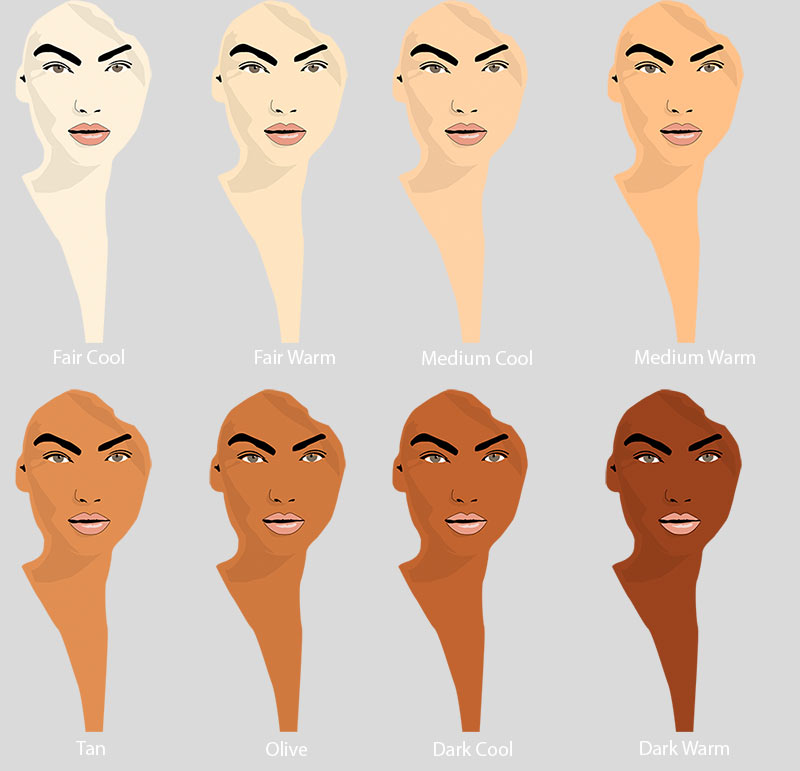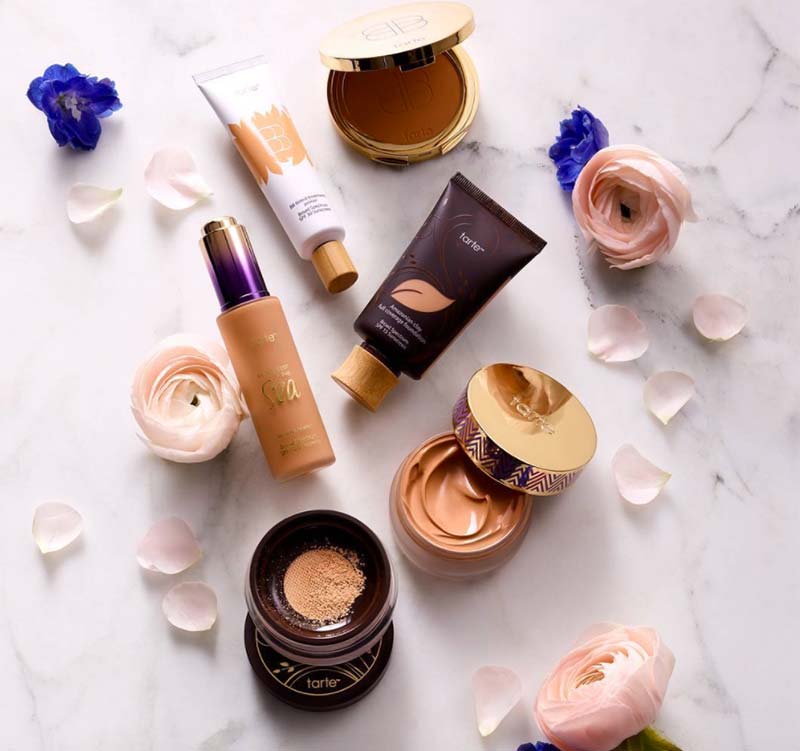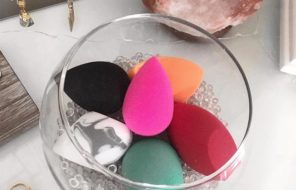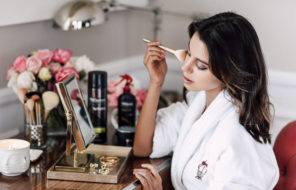There are so many different types of foundations on the market, let alone the vast array of shades you have to go through to figure out what works best for you. Other than knowing the best foundations of all time, you need to know your skin well to pick your holy-grail makeup. Below, find out how to choose the best foundation for your skin type and tone, as well as for every season!
In this article:
- How to Choose the Best Foundation for Your Skin Tone
- How to Choose the Best Foundation for Your Skin Type
- Choosing the Right Foundation for Every Season
How to Choose the Best Foundation for Your Skin Tone
Finding the right foundation for your skin tone can be tough, because you have to think about two things: your skin’s undertone, and its level of paleness/ darkness. I used to get really confused, not understanding why foundations looked dark and wrong on my pale skin even though they seemed fairly light in the bottle. I had to understand my undertone before I could find a foundation that matched me perfectly.
Follow these tips to figure out your skin undertone:
- Think of your skin as if it were a shade of brown that is made up of three primary colors: red, blue, and yellow, along with white or black (depending on how dark or light you are). A perfect balance of the three colors would make your skin neutral.
- On the warm side you have skin that has extra yellow, while a mixture of yellow and blue would make one’s skin olive-toned.
- Cool skin will have slightly higher quantities of red or blue pigment.
- Neutral skin will usually look either perfectly beige, or perhaps a touch orange.
This kind of classification can be confusing, because it does not directly correspond to the way artists classify cool and warm skin tones.
It can be quite difficult to figure out the undertones in one’s skin. The key is not to look at the face – our faces are exposed to the harsh elements more so than other parts of our body, and things like sun damage tend to make us lean towards red. Instead, look at your neck and chest, or at your forearm.

If you hold a sheet of white paper next to your skin, it will actually help balance your vision and allow you to better determine your skin undertone. You can also look at the veins on your forearm for clues. If they seem more green, your skin leans towards warm, whereas if they seem a touch purple you have a cool undertone. If they are mostly blue then you have neutral skin.
An old trick suggests checking whether gold jewelry or blue shirts look good on you… which is pretty silly, if you ask me, since contrasting colors can look just as good as complementary ones.
If you really can’t figure out your skin tone, go to a few different beauty consultants and ask them what they think!
Once you can see undertones, you’ll have an easier time picking them out in different foundations (especially now when brands tend to make it quite clear what the undertones of their foundation are).
- Foundations with a red, rose or blue base are perfect for those with cool undertones. As for the shades of foundation for cool skin tones, go for porcelain, sable, cocoa and rose colors, testing to see which one looks more natural on your skin.
- Gold or yellow-based foundations are recommended for warm skin undertones. Beige, caramel, chestnut, golden and tan shades will be your best friends.
- Ivory, nude, praline and buff foundation shades are meant for neutral skin tones.
To actually test foundations to see if they’re a fit, take your foundation of choice and swipe it along your jawline. Blend it out a little bit, but not quite as much as you would if you were to apply it to your whole face. You can even do this with a few different foundations.
Look at the foundation (or foundations) in a large mirror – don’t stand too closely to it. Whichever foundation seems to disappear best into your neck is likely your best match.
This method is my favorite, although often our chests are a touch darker than our necks, since they get more sun. If your neck is considerably darker than your neck, you might want to choose a foundation that is somewhere between the two colors, or you might choose a foundation that matches your chest, and just blend it all the way down your neck.
How to Choose the Best Foundation for Your Skin Type
Besides your skin tone and undertone, you should also consifer your skin type while choosing the best foundation for you in order to get that flawless, long-lasting look after the application.
Best Foundations for Dry or Mature Skin
Your best bet is using a liquid foundation that is either oil- or silicone-based. Look specifically for foundations that are marketed as creamy, hydrating, or luminizing. These foundations will help perfect your skin without emphasizing wrinkles or dry patches, and they might even moisturize a little!
Stay away from mattifying foundations, cream-to-powder foundations, or powder foundations, as these can all emphasize dryness and have your skin looking parched.
Best Foundations for Oily or Combination-Oily Skin
Water- and silicone-based foundations are perfect for oily skin types. Water-based foundations will resist your skin’s oils and keep you looking matte, while silicone-based foundations will hide large pores and have a blurring effect on your skin.
If you prefer lighter coverage, you can even opt for a powder foundation. Additionally, if you occasionally suffer from breakouts, you can find medicated foundations that will simultaneously treat and hide your acne.
Best Foundations for Normal Skin
Lucky you! It is really up to your preferences: whether you want a high-coverage or low-coverage foundation, whether you like a dewy or matte finish, and whether you find it easier to apply a cream, powder, or liquid foundation, chances are almost any foundation will work well for you.

Choosing the Right Foundation for Every Season
Different foundations work better with different climates. Both temperature and humidity level will have an impact on which types of foundations you should choose.
Remember that about half way through every season you should double check your foundation color match, because your skin tone will be changing!
Best Foundations for Summer
It seems that much harder to keep foundation on the skin during the summer, not to mention that the feeling of heavy foundations mixed with sweat is kind of disgusting. Unless your skin is chronically dry, you will probably prefer a lighter yet more mattifying foundations during summer.
Powder foundations are a great way to go in the summer, for staying matte and feeling light. If you prefer something creamy or hydrating, opt for a mattifying tinted moisturizer or a BB/CC cream – the more SPF, the better.
In the summer, it is better to stay away from heavy cream foundations. If you need coverage, target specific areas with a concealer, instead.
Best Foundations for Fall
Fall is a great season for the skin, because the air is usually more saturated with moisture without any of that terrible sun. The autumn season often calls for a cozy matte finish, but that’s just style – if you like a dewy finish, do you!
In the autumn, look at your skin type for foundation choice, because almost anything could work. This transitional season is also the time to double-check your color match, since you will be losing that summer tan.
Best Foundations for Winter
Our skin tends to get dry in winter, so it is the perfect time to switch to a creamier formula. Stay away from anything overly mattifying, and instead opt for luxurious liquid or cream foundations with lots of hydrating properties (I have a lot of options coming up below!).
Best Foundations for Spring
Spring is so fresh and lovely, so it is the perfect time to embrace a dewy, creamy finish. Much like autumn, it is best to go off of your skin type when choosing a perfect foundation, because this season is not fussy!
Photos via Instagram




